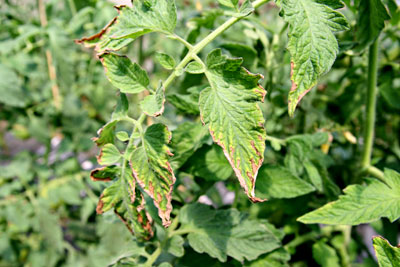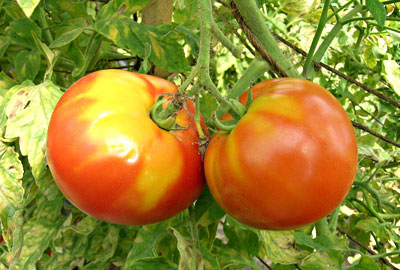 |
| Potassium deficiency on tomato leaves appears as mottled chlorosis (yellowing) and tip burn. Sideman photo. |
 |
| Yellow shoulder on tomatoes has no single cause but is related to a lack of foliage, varietal susceptibility and potassium deficiency. Sideman photo. |
By Eric Sideman, Ph.D.
In the past two issues of The MOF&G, I discussed the plant mineral elements nitrogen and phosphorus. The third of the three nutrients most commonly limiting crop growth on farms and in gardens is potassium. Fertilizers come with three numbers printed on the bag, such as 10-10-10. These refer to amounts of these three nutrients, N (nitrogen), P (phosphorus) and K (potassium).
Growers concentrate on providing these three nutrients, because all other nutrients that plants need usually accumulate in the soil from sources other than fertilizers. Calcium and magnesium usually are adequate from limestone that growers use to adjust the soil pH. Sulfur is usually adequate from acid rain, a result of air pollution from coal-fired power plants – although, because of the Clean Air Act, air is less polluted, and some soils are deficient in sulfur now, so growers need to pay attention to this element.
Plants need 10 or 11 other nutrients to live and grow, but in such small amounts that they are usually sufficient on organic farms because of the amount and diversity of organic matter added to the soil. I suggest that growers ensure that their soils have sufficient macronutrients, and that they tend to other cultural needs, such as weed management, before considering micronutrients as a limiting factor.
Potassium in Plants
Potassium deficiency shows up as yellowing (chlorosis) between the veins of leaves, especially at the leaf edges and tips. Potassium is very mobile in the plant, and plants move it to the younger, needy tissue when it becomes limiting. Hence potassium deficiency begins with a mottled chlorosis of the older leaves first and can later occur in younger leaves too. Eventually the leaf edges become brown.
Some plants need large amounts of potassium and show unusual deficiency symptoms. For example, yellow shoulder (uneven ripening) in tomatoes is related to potassium deficiency, as are weak stems and lodging (falling over) in grains.
Potassium is not a structural part of plant tissue to any significant degree. It occurs mostly in the fluids in the plant, where it regulates turgor pressure, opening and closing the stomates, and plant metabolism. This is important regarding potassium fertility in soils, because organic matter is not such an important source of potassium as it is of nitrogen and phosphorus. So on organic farms, biological activity is not as critical for potassium availability as it is for nitrogen and phosphorus availability. Basically, potassium is supplied to agricultural land in a mineral form and it dissolves in the soil water and is available to the plant.
Typical sources include mined rock powders and wood ash. Of course, manures, compost and other organic materials are potassium sources, too, because even though the concentration of potassium in them is pretty low, typically a lot of material is applied to a field.
Before considering potassium sources, determine whether you need potassium – which is not as simple as applying the amount of potassium a crop needs. The relative proportion of potassium to other cationic (positively charged) nutrients appears to be important. Some people do not believe this, and others carry it to extremes. I am in the middle. Although little research exists to demonstrate the importance of the so-called “cation saturation ratio,” enough does exist to convince many soil testing laboratories and me that it should be considered.
Simple Chemistry
Everything is made of atoms, and atoms contain electrons, which are negatively charged.
Atoms combine to form different kinds of materials. For example, water is made of oxygen and hydrogen atoms linked together by sharing electrons. Other kinds of materials form when atoms do not share electrons per se, but electrons move from one atom to the other, forming an “ionic bond.”
Within each atom, the negative charge of its electrons is balanced by the positive charge of another part called a proton. If an atom gains or loses an electron, its charge changes. For example, if an atom gains an electron, it carries an extra negative charge. If an atom loses an electron, it carries a positive charge. The attraction of these positive and negative charges to one another in the charged atoms creates the bond.
Table salt, for example, is a material made when atoms form an ionic bond. Table salt is made of sodium and chlorine. The sodium gives up an electron to the chlorine, so the sodium becomes positively charged (by losing a negative electron), and the chlorine becomes negatively charged (by gaining a negative electron). Negatively charged chlorine is called chloride. The opposite charges of the two atoms bind the two together, forming sodium chloride, or table salt.
Materials with ionic bonds break apart when they dissolve; the charged atoms separate in solution. For example, table salt dissolved in water becomes sodium and chloride ions. The sodium ion has a positive charge, and the chloride ion has a negative charge.
Positively charged ions are called cations. Many plant nutrients are cations. Magnesium, calcium and potassium are the most important plant nutrients that exist in soil solutions as cations. Since they are somewhat similar, they compete for absorption by the plant. This is the basis for the idea that an “ideal” ratio of these nutrients exists.
Cations are held in the soil on parts of the soil – clay and organic matter – that have negatively charged surfaces. The capacity of a soil to hold cations is called the cation exchange capacity (CEC). Not only is the capacity (the total amount of cations a soil can hold) important, but the ratio of different cations is thought to be important. An ideal soil is thought to have 2 to 4 percent of its cation exchange sites occupied by potassium, 10 to 20 percent by magnesium, 60 to 80 percent by calcium, and less than 10 percent by other cations (such as a hydrogen or aluminum ion) that are not plant nutrients.
Whether plants get enough potassium to grow depends not only on the amount of potassium in a soil, but also on the amount of other cations in the soil. So you need to know the total cation exchange capacity and the percent of those exchange sites occupied by potassium. A standard Maine soil test reports both numbers. A cation exchange capacity (CEC) of 5 or greater, with 2 to 4 percent of that occupied by potassium, is good.
If the CEC is less than 5 (that is, the soil does not have many negative sites to hold cations), then having the proper ratio of potassium may not provide enough potassium to feed crops for a whole season; you may have to add potassium fertilizers twice a year instead of once in spring.
Potassium Fertilizing
To change the ratio of cations, add fertilizers high in the needed nutrient. I think of this as musical chairs: Negatively charged exchange sites that hold cations in the soil are the chairs, and the cation nutrients floating around in the soil solution are the people playing musical chairs. You improve the chance of certain cations getting the chairs if you increase the proportion of them in the soil solution. That is what you do when you add fertilizers. If you have very little potassium, or a low proportion of potassium on the cation exchange sites, you need to add a fertilizer high in potassium to the soil to increase the proportion of potassium in the soil solution and the chance of potassium getting the chairs (i.e., occupying the negatively charged cation exchange sites).
I recommend these sources of potassium:
Sul-Po-Mag (0-0-22, with 11 percent magnesium), a mined rock commonly used as a potassium source in conventional fertilizers, is the most economical source of available potassium for organic growers – but be sure to use a brand approved for organic production. (Many brands in stores are not approved because they contain dust suppressants and/or coatings.) Use it only if magnesium is needed too. Sul-Po-Mag is a good source of magnesium if no pH adjustment is needed. Its nutrients are available to plants immediately. Use it when the crop is growing.
Wood Ash (0-1-5) supplies potassium quickly, so apply ashes shortly before the crop needs potassium. Wood ash has two-thirds the liming power of limestone and acts very quickly, so do not use wood ash for potassium unless you also need to adjust the soil pH.
Potassium sulfate (0-0-50) is available in natural and synthetic forms; only the natural is permitted on organic farms, so check with the supplier before purchasing it. This inexpensive (considering the analysis) material adds potassium to the soil without any other cations. It is very soluble and should be used only when crops are growing or will soon grow; otherwise it will likely be lost by leaching.
I want to stress that potassium is very soluble, so add potassium fertilizers close to when crops will be growing. Don’t add them in the fall for spring crops, because most of the potassium will be gone by then.
Also, while microbes dependably hold nitrogen and phosphorus in their bodies in the soil, they have little use for potassium. So if you plow down a cover crop that is high in potassium, plant a cash crop or another cover crop to grab it, because the microbes won’t.
Eric Sideman is MOFGA’s organic crop specialist. Contact him with your questions at [email protected] or 568-4142.
